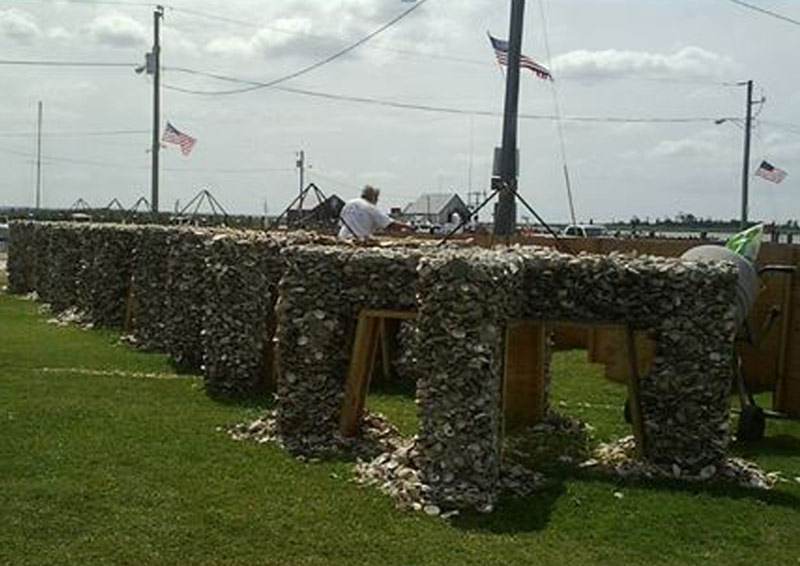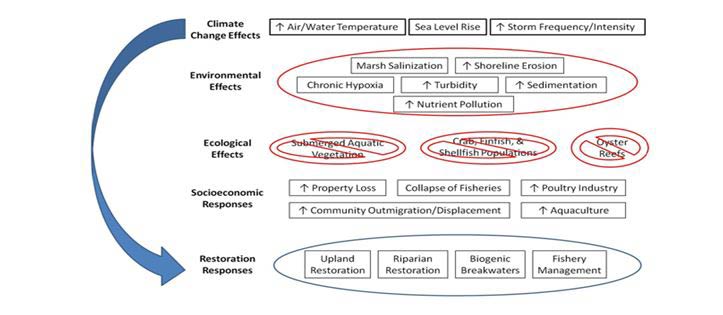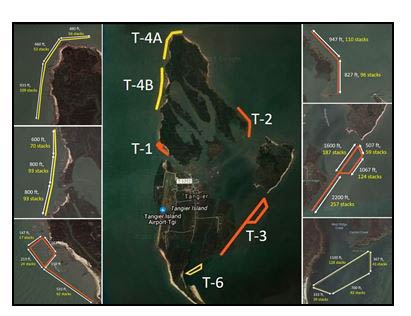Sustainable shoreline protection solutions
With rising seas and a higher frequency of intense storms how will coastal communities and entire nations protect their vulnerable shorelines? In the US they have found it needs a combination of approaches.
[X-Reefs constructed at the Saxis Reef Staging Area with the assistance of Saxis citizens and supporters (Photo Credit: Darryl Nixon, Broadwater Concepts).]
Contents |
[edit] Project details
- Location: Saxis, Virginia, USA; Tangier, Virginia, USA
- Value: Saxis Project - $130,000 USD; Tangier Project - $3,000,000 USD (estimated)
- Date of completion: Saxis Project – Ongoing but set for completion by summer 2018; Tangier Project – planning stage, no construction date yet.
- Challenge summary: Shoreline/and erosion solutions.
[edit] Introduction
Humanity’s contribution to climate change remains a politically-charged topic. But coastal communities are hard-pressed to deny that shoreline development loss of natural habitats such as fringing reefs, wetlands, and seagrass beds, and rising sea level, have combined to produce significant issues of erosion and flooding.
In fact, in many areas, many communities are experiencing regular tidal flooding once reserved only for major storms. Accompanied by these rising waters is a seemingly unrelenting and unabated wave energy force that systematically wears away riparian and even more upland habitats. In other words, owners/managers of private, commercial properties, municipal and state-owned lands are experiencing a phenomenon where the land is eroding right out from under them - a process typically only observable over elapsed time but seen in real time by storms.
Though major tropical storms such as named hurricanes receive much of the popular media’s focus it is the chronic erosion and flooding that warrants international attention and action. In the US alone, more than 39% of the population lives within coastal counties, a number projected to increase by 10% within the next 10-plus years (NOAA Ocean Facts).
[edit] The traditional response to mitigate flood and erosion damage
The conventional approaches to the encroachment of coastal waters into low lying cities and towns has been a combination of seawalls, breakwaters, floodgates, elevation of structures such as homes and businesses, and a variety of shoreline-armouring methods.
Unfortunately, shoreline hardening has taken its toll on nearby ecosystems such as oyster reefs, tidal wetlands, and submerged aquatic vegetation beds (i.e. seagrass). This loss of habitat has negatively impacted finfish, crustacean, and shellfish populations resulting in reduced commercial and recreational fishing revenue.
Beyond that, the loss of once-expansive wetlands has directly resulted in a decline in water quality and reduction of flood protection – a well-known service provided by wetlands around the world. Of concern is that many of the ‘tried-and-true’ shoreline protection methods are failing or are too expensive to implement at larger scales.
[Figure 1. Schematic of how coastal communities respond to the effects of centuries of anthropogenic activities – effects that are clearly being compounded by climate change forces including sea-level rise and increasing frequency/intensity of storms (Image credit: Russell Burke).]
[edit] Local innovative solutions to a global problem
Since 2003, hurricanes Isabel, Katrina, Wilma, Sandy, Harvey and Irma have ravaged the Atlantic and Gulf Coasts of the US. Shoreline damage and loss from those storms, and chronic wave energy impact over that same time span, have prompted a movement to generate innovative, cost-effective shoreline protection solutions. Specifically, solutions that focus on habitat restoration – and not just shoreline hardening – have been encouraged.
As a result, a variety of designs have been implemented, ranging from nearshore living shorelines to offshore biogenic breakwaters. Coordination between federal, state, and local governments with non-profit organizations and small businesses has been a key component for strategic installation and assessment of these designs.
In addition, participation of local communities in project development, deployment, and monitoring has proven to be an important element to engage and educate those who are poised to benefit most from such efforts.
For example, in the town of Saxis, Virginia (US), a partnership between the town, Christopher Newport University (CNU), the Virginia Ecological Solutions Foundation (VESF), and two small Virginia-owned companies, Broadwater Concepts and the Oyster Company of Virginia has produced a grass-roots campaign to construct large biogenic breakwater reefs for protection of the municipal pier located at the southern tip of the island with funding support from the Environmental Protection Agency.
These reef structures (see image below) are intended to 1) attenuate wave energy and mitigate ongoing erosion, 2) enhance water quality and fisheries habitat, and 3) educate recreational users at the fishing pier on the benefits of the project and its coastal resilience initiatives. The project is ongoing and will be completed by summer 2018.
[Oyster shell-embedded, X-Reefs (Broadwater Concepts, Ready Reef, Inc. and Biogenic Solutions Consulting, LLC) placed beneath a pier along an eroding shoreline in Mathews, Virginia (Photo Credits: Russell Burke, Davis Little).]
Nearby, in the middle of Chesapeake Bay, the town of Tangier has partnered with the US Army Corps of Engineers (USACE), the Accomack-Northampton Planning District Commission, CNU, OCVA, and VESF to undertake a bold programme to save the island from erosion and projected permanent submersion – a threat documented by the USACE in a recent Nature Scientific Report (Schulte et al. 2015).
Some projections show the town becoming uninhabitable in as little as 30 years.
[Current and projected future landmass of the Tangier Islands (Schulte et al. 2015).]
The Tangier partners have prioritised 6 phases from most to least urgent.
[Phased shoreline protection plan of the Tangier Island stakeholder group (Image Credit: Russell Burke, Curt Smith).]
Plans call for the offshore deployment of prefabricated Reeftek sentinels – concrete modular reefs that stack to provide significant wave energy attenuation as well as a wide variety of settlement surfaces for encrusting organisms which subsequently attract numerous finfish and crab species.
[Schematic of the Oyster Company of Virginia’s concrete modular reef design set to be used in Saxis and Tangier, Virginia (Image Credit: OCVA, VESF).]
[Concrete modular reefs encrusted with oysters, mussels, and red beard sponge just five years after installation in the lower Rappahannock River, Virginia (Photo Credits: Russell Burke, Capt. Robert Jensen).]
The nearshore erosion solution of oyster shell-embedded, diamond-shaped reefs directly engages the Tangier Island community and visiting tourists as they are set to participate in reef construction and project installation with reef moulds donated to Tangier with funding support from CNU.
[Oyster shell-embedded, diamond-shaped reefs (Ready Reef, Inc. and Biogenic Solutions Consulting, LLC) placed along an eroding shoreline in Mathews, Virginia (Photo Credits: Russell Burke, Davis Little).]
[edit] Conclusions: adaptive engineering, affordability, local manufacture, community support
The projects at Saxis and Tangier show that new shoreline protection methods can provide innovative structures for colonisation by crustaceans that can adapt to sea level rise and more frequent storms. They can also incorporate significant elements of community engagement with those communities most at risk from sea level rise and more frequent storm, by using local manufacture of structures and community labour for installation. Furthermore, these new shoreline protection methods are also very much cheaper than traditional methods .
Many factors are increasing the pressure to deliver new shoreline protection measures. For example, the very active hurricane season in 2017 in the Caribbean and eastern seaboard of the US, national TV coverage about the effects of climate change on communities such as Tangier Island (CNN 2017), and the recent invitation from President Donald Trump to the mayor of Tangier to discuss future options to protect the town from eroding away (personal communication, Mayor James Eskridge).
The powerful combination of these 4 benefits – adaptive engineering, affordability, local manufacture and strong community support – will be the most effective in getting more X-reefs and modular reefs installed to protect coastal communities.
This article was originally published here by ICE on 17 November 2017. It was written by <a>Russell Burke, Christopher Newport University, US</a>.
--The Institution of Civil Engineers
[edit] Related articles on Designing Buildings
Featured articles and news
Infrastructure that connect the physical and digital domains.
Harnessing robotics and AI in challenging environments
The key to nuclear decommissioning and fusion engineering.
BSRIA announces Lisa Ashworth as new CEO
Tasked with furthering BSRIA’s impressive growth ambitions.
Public buildings get half a million energy efficiency boost
£557 million to switch to cleaner heating and save on energy.
CIOB launches pre-election manifesto
Outlining potential future policies for the next government.
Grenfell Tower Inquiry announcement
Phase 2 hearings come to a close and the final report due in September.
Progress from Parts L, F and O: A whitepaper, one year on.
A replicated study to understand the opinion of practitioners.
ECA announces new president 2024
Electrical engineer and business leader Stuart Smith.
A distinct type of countryside that should be celebrated.
Should Part O be extended to existing buildings?
EAC brands heatwave adaptation a missed opportunity.
Definition of Statutory in workplace and facilities management
Established by IWFM, BESA, CIBSE and BSRIA.
Tackling the transition from traditional heating systems
59% lack the necessary information and confidence to switch.
The general election and the construction industry
As PM, Rishi Sunak announces July 4 date for an election.
Eco apprenticeships continue help grow green workforce
A year after being recognised at the King's coronation.
Permitted development rights for agricultural buildings
The changes coming into effect as of May 21, 2024.






























